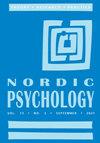The Quantified Behavioural Test Plus (QbTest+) in adult ADHD
IF 1.1
4区 心理学
Q4 PSYCHOLOGY, MULTIDISCIPLINARY
引用次数: 2
Abstract
Abstract The Quantified Behavioural Test Plus (QbTest+) is widely used in clinical practice to assess patients with attention-deficit hyperactivity disorder (ADHD). This study mapped its behaviour in a group of adults with ADHD. Does it signal problems with impulsivity, attention and/or activity? To what extent are patients’ self-reported problems reflected in QbTest performance? Does Qb testing foretell the future, as reflected in the patients’ and clinicians’ judgements 4 years later? We here recorded the three QbTest+ cardinals–QbActivity, QbImpulsivity and QbInattention – in 67 consecutive ADHD patients diagnosed in adulthood. Among the 54 patients who medicated as usual on the day of testing, 35 (65%) scored above the clinical cut-off (Q-score ≥ 1.25) on at least one of the QbTest+ cardinals. Out of the 13 patients who suspended medication prior to the test, 11 (85%) scored above the clinical cut-off on at least one of the Qb-variables. There were modest associations between QbTest+ cardinals and symptom self-ratings [Brown ADD scale (BADDS); Adult Self-Report Scale (ASRS)]. Forty-one patients completed a second QbTest+ approximately 4 years after the first. Performance was improved on the follow-up test and fewer patients scored in the clinical range (34%). The scores on the QbInattention cardinal at baseline correlated positively with BADDS and ASRS self-ratings at the 4-year follow-up.定量行为测试+ (QbTest+)在成人多动症中的应用
QbTest+ (Quantified Behavioural Test Plus)被广泛应用于临床对注意缺陷多动障碍(ADHD)患者进行评估。这项研究在一组患有多动症的成年人中绘制了它的行为图。它是否预示着冲动、注意力和/或活动方面的问题?病人自我报告的问题在多大程度上反映在QbTest的表现上?Qb测试是否预示了未来,正如4年后患者和临床医生的判断所反映的那样?我们在这里记录了67名连续诊断为成年期ADHD患者的三个QbTest+基数——qbactivity, qb冲动性和qbattention。在测试当天照常用药的54例患者中,35例(65%)在至少一项QbTest+基数上得分高于临床临界值(q评分≥1.25)。在测试前暂停用药的13例患者中,11例(85%)在至少一个qb变量上得分高于临床临界值。QbTest+基数与症状自评之间存在适度关联[Brown ADD量表(badd);成人自我报告量表[j]。41名患者在第一次测试后大约4年完成了第二次QbTest+。随访测试的表现得到改善,在临床范围内得分的患者减少(34%)。基线时的QbInattention基数得分与4年随访时的badd和ASRS自评呈正相关。
本文章由计算机程序翻译,如有差异,请以英文原文为准。
求助全文
约1分钟内获得全文
求助全文

 求助内容:
求助内容: 应助结果提醒方式:
应助结果提醒方式:


